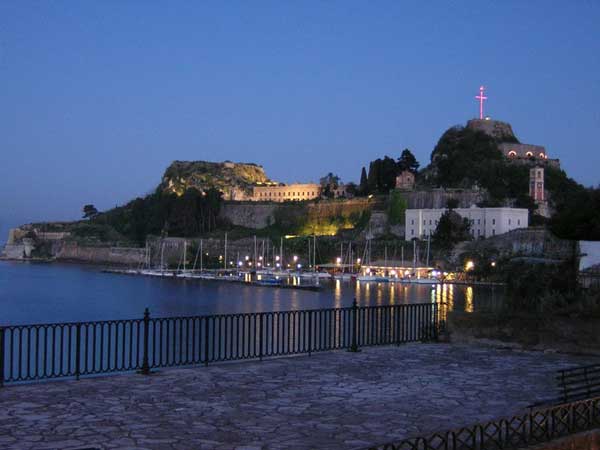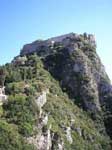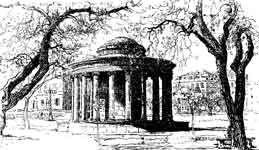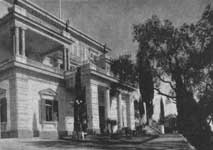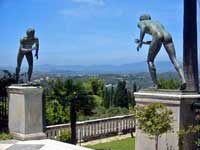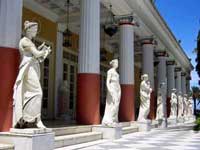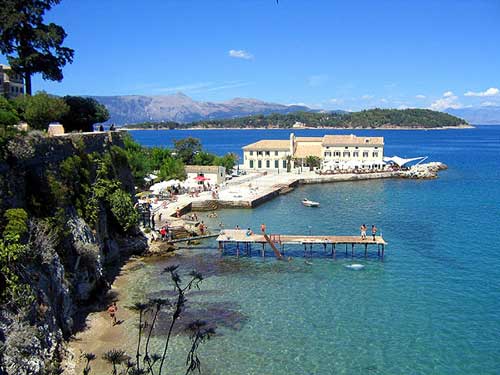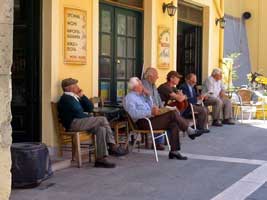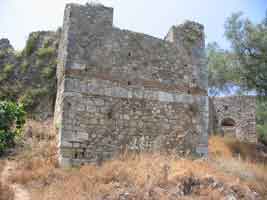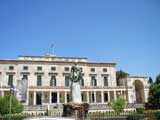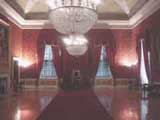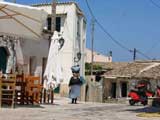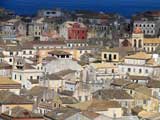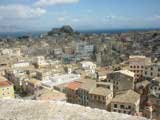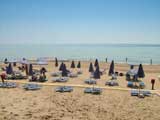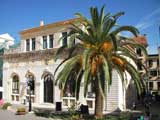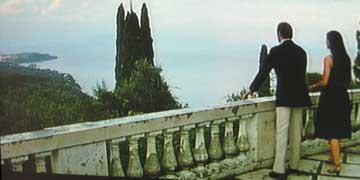.
Administrative Region : Ionian Islands
Regional unit : Kerkyra
Kerkyra better known as Corfu (Greek: Κέρκυρα, Kérkyra, [ˈcercira]; Ancient Greek: Κέρκυρα or Κόρκυρα; Latin: Corcyra; Italian: Corfù) is a Greek island in the Ionian Sea. It is the second largest of the Ionian Islands,[1] and, including its small satellite islands, forms the edge of the northwestern frontier of Greece.[2] The island is part of the Corfu regional unit, and is administered as a single municipality. The municipality includes the island Corfu and the smaller islands Ereikoussa, Mathraki and Othonoi. The principal city of the island and seat of the municipality (pop. 33,886) is also named Corfu.[3] Corfu is home to the Ionian University.
The island is connected to the history of Greece from the beginning of Greek mythology. Its Greek name, Kerkyra or Korkyra, is related to two powerful water symbols: Poseidon, god of the sea, and Asopos, an important Greek mainland river.[4] According to myth, Poseidon fell in love with the beautiful nymph Korkyra, daughter of Asopus and river nymph Metope, and abducted her.[4] Poseidon brought Korkyra to the hitherto unnamed island and, in marital bliss, offered her name to the place: Korkyra,[4] which gradually evolved to Kerkyra (Doric).[5] Together, they had a child they called Phaiax, after whom the inhabitants of the island were named: Phaiakes. This term was transliterated via Latin to Phaeacians.
The island's history is laden with battles and conquests. The legacy of these struggles is visible in the form of castles punctuating strategic locations across the island. Two of these castles enclose its capital, which is the only city in Greece to be surrounded in such a way. As a result, Corfu's capital has been officially declared a Kastropolis ("castle city") by the Greek government.[5] Corfu was long controlled by Venice, which repulsed several Turkish sieges, before falling under British rule following the Napoleonic Wars. Corfu was eventually ceded by the British Empire along with the remaining islands of the United States of the Ionian Islands, and unification with modern Greece was concluded in 1864 under the Treaty of London.
In 2007, the city's old city was designated for the UNESCO World Heritage List, following a recommendation by ICOMOS.[6][7][8]

The town of Corfu seen from the sea, south of the harbor. The new citadel at the right of the photo
Corfu is a very popular tourist destination.[9][10] Up until the early 20th century, it was mainly visited by the European royals and elites, including Emperor Wilhelm II of Germany and Empress Elisabeth of Austria; today it is also widely visited by middle class families, (primarily from the UK, Scandinavia and Germany) leading to mass tourism.[11] It is still popular with the global elite however, and in the island's northeast the homeowners include members of the Rothschild family and Russian oligarchs.[12][13]
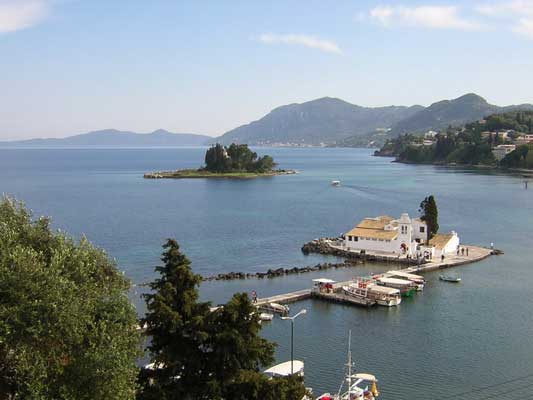
Pontikonisi Island in the background with the Vlaheraina Monastery in the foreground. The shuttle boats that ferry people to and from Pontikonisi can be seen moored in the marina near the Monastery. Pontikonisi is home of the monastery of Pantokrator (Μοναστήρι του Παντοκράτορος). It is the white stone staircase of the Monastery of Pantokrator that when viewed from afar gives the impression of a (mouse) tail that gave the island its name: Mouse island. The trees at the lower left of the picture are from the hills of Kanoni. The hilltops at the upper right corner is the southern part of the island with Perama, Kaiser's Bridge, Benitses and Mesonghi forming an arc of popular beaches and tourist attractions as one gazes southbound from Kanoni. Farthest south is Lefkimmi and cape Kavos.
Geography
Map of Corfu. Its satellite islands of Ereikousa, Othoni and Mathraki counterclockwise NW, WNW and W respectively (with respect to the northern part of the island at the top of the map) and Paxoi and Antipaxoi on the SE side, are visible.
The north-eastern coastline of Corfu lies off the coast of Sarandë, Albania, from which it is separated by straits varying in width from 3 to 23 km (2 to 15 mi), while the south-east side of the island lies off the coast of Thesprotia, Greece. The name "Corfu", an Italian version of the Byzantine Κορυφώ (Koryphō), meaning "city of the peaks", derives from the Greek Κορυφαί (Koryphai) (crests or peaks), denoting the two peaks of Palaio Frourio.[5] In shape it is like the sickle (drepanē, δρεπάνι), to which it was compared by the ancients: the concave side, with the city and harbour of Corfu in the centre, lies toward the Albanian coast. With the island's area estimated at 227 square miles (588 km2), it runs approximately 40 miles (64 km) long, with greatest breadth at around 20 miles (32 km).
Two high and well-defined ranges divide the island into three districts, of which the northern is mountainous, the central undulating, and the southern low-lying. The more important of the two ranges, that of Pantokrator (Παντοκράτωρ - the ancient Istone) stretches east and west from Cape Falacro to Cape Psaromita, and attains its greatest elevation in the summit of the same name.
Bay of St. George in northwestern Corfu

The Corfu Lion, or "Lion of Menecrates" (near his Cenotaph) end of 7th century BC
The second range culminates in the mountain of Santi Jeca, or Santa Decca, as it is called by misinterpretation of the Greek designation Άγιοι Δέκα (Hagioi Deka), or the Ten Saints. The whole island, composed as it is of various limestone formations, presents great diversity of surface, and views from more elevated spots are magnificent. Beaches are found in Agios Gordis, the Korission lagoon, Agios Georgios, Marathia, Kassiopi, Sidari, Palaiokastritsa and many others. Corfu is located near the Kefalonia geological fault formation; earthquakes have occurred. Corfu city and countryside have not lost the traditional architecture from the 16th century.
Corfu's coastline spans 217 kilometres (135 mi) including capes; its highest point is Mount Pantokrator (906 metres (2,972 ft)); and the second Stravoskiadi, at 849 metres (2,785 ft). The full extent of capes and promentories take in Agia Aikaterini, Drastis to the north, Lefkimmi and Asprokavos to the southeast, and Megachoro to the south. Two islands are also to be found at a middle point of Gouvia and Corfu Bay, which extends across much of the eastern shore of the island; are known as Lazareto and Ptychia (or Vido). Camping areas can be found in Palaiokastritsa, Agrillia, with four in the northern part, Pyrgi, Roda, Gouvia and Messonghi.
Flora
Homer identifies seven plants that adorn the garden of Alcinous: wild olive, oil olive, pear, pomegranate, apple, fig and grape vine. Of these the apple and the pear are As of 2011 very inferior[CN] in Corfu; the others thrive, together with all the fruit trees known in southern Europe, with addition of the kumquat, loquat and prickly pear and, in some spots, the banana. When undisturbed by cultivation, the myrtle, arbutus, bay and holm oak form a rich brushwood, and the minor flora of the island are extensive.
Climate
| Climate data for Corfu | |||||||||||||
|---|---|---|---|---|---|---|---|---|---|---|---|---|---|
| Month | Jan | Feb | Mar | Apr | May | Jun | Jul | Aug | Sep | Oct | Nov | Dec | Year |
| Average high °C (°F) | 14 (57) |
14 (57) |
16 (61) |
19 (66) |
23 (73) |
28 (82) |
31 (88) |
31 (88) |
28 (82) |
23 (73) |
18 (64) |
15 (59) |
22 |
| Average low °C (°F) | 5 (41) |
6 (43) |
7 (45) |
9 (48) |
13 (55) |
16 (61) |
18 (64) |
18 (64) |
16 (61) |
13 (55) |
9 (48) |
7 (45) |
11 |
| Precipitation mm (inches) | 132.1 (5.201) |
137.2 (5.402) |
99.1 (3.902) |
61 (2.4) |
35.6 (1.402) |
15.2 (0.598) |
7.6 (0.299) |
17.8 (0.701) |
76.2 (3) |
147.3 (5.799) |
180.3 (7.098) |
180.3 (7.098) |
1,089.7 (42.902) |
| Source: Weather Channel[14] | |||||||||||||
Urban landscape
Panoramic view of parts of old Corfu City as seen from Palaio Frourio. The Bay of Garitsa is to the left and the port of Corfu is just visible on the top right of the picture. Spianada is on the foreground
Old town
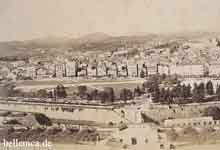

Main article: Corfu (city)
Corfu City Hall (previously: Nobile Teatro di San Giacomo di Corfù).
The city of Corfu stands on the broad part of a peninsula, whose termination in the Venetian citadel (Greek: Παλαιό Φρούριο) is cut off from it by an artificial fosse formed in a natural gully, with a seawater moat at the bottom, that now serves as a marina and is called the Contrafossa. The old town, having grown within fortifications, where every metre of ground was precious, is a labyrinth of narrow streets paved with cobblestones, sometimes tortuous but colourful and clean. These streets are known as kantoúnia (Greek: καντούνια), and the older amongst them sometimes follow the gentle irregularities of the ground; while many are too narrow for vehicular traffic. A promenade rises by the seashore towards the bay of Garitsa (Γαρίτσα), together with an esplanade between the city and the citadel known as Spianada with the Liston (it) arcade (Greek: Λιστόν) to its west side, where restaurants and bistros abound.[1]
Palaio Frourio
Palaio Frourio south elevation. The Venetian built moat is on the left and the Doric style St. George's Church built by the British can be seen in the background on the right.
The old citadel (in Greek Palaio Frourio (Παλαιό Φρούριο)) is an old Venetian fortress built on an artificial islet with fortifications surrounding its entire perimeter, although some sections, particularly on the east side, are slowly being eroded and falling into the sea. Nonetheless, the interior has been restored and is in use for cultural events, such as concerts (συναυλίες) and Sound and Light Productions (Ηχος και Φως), when historical events are recreated using sound and light special effects. These events take place amidst the ancient fortifications, with the Ionian sea in the background. The central high point of the citadel rises like a giant natural obelisk complete with a military observation post at the top, with a giant cross at its apex; at the foot of the observatory lies St. George's church, in a classical style punctuated by six Doric columns,[15] as opposed to the Byzantine architectural style of the greater part of Greek Orthodox churches. (built during British rule as military Anglican church)
Neo Frourio
The new citadel or Neo Frourio (Νέο Φρούριο, "New Fortress") is a huge complex of fortifications dominating the northeastern part of the city; the huge walls of the fortress dominate the landscape as one makes the trip from Neo Limani (Νέο Λιμάνι, "New Port") to the city, taking the road that passes through the fishmarket (ψαραγορά). The new citadel was until recently a restricted area due to the presence of a naval garrison, but old restrictions have been lifted and it is now open to the public, with tours possible through the maze of medieval corridors and fortifications. The winged Lion of St Mark, the symbol of Venice, can be seen at regular intervals adorning the fortifications.
Ano and Kato Plateia and the music pavilion
The Maitland Monument in Corfu, built to commemorate Sir Thomas Maitland
Near the old Venetian Citadel a large square called Spianada is also to be found, divided by a street in two parts: "Ano Plateia" (literally: "Upper square") and "Kato Plateia" (literally: "Lower square"), (Ανω Πλατεία and Κάτω Πλατεία in Greek). This is the biggest square in South-Eastern Europe and one of the largest in Europe,[16][17] and replete with green spaces and interesting structures, such as a Roman-style rotunda from the era of British administration, known as the Maitland monument, built to commemorate Sir Thomas Maitland. An ornate music pavilion is also present, where the local "Philharmonikes" (Philharmonic Orchestras) (Φιλαρμονικές), mount classical performances in the artistic and musical tradition for which the island is well-known. "Kato Plateia" also serves as a venue where cricket matches are held from time to time. In Greece, cricket is unique to Corfu, as it was once a British protectorate.
Palaia Anaktora and gardens
The Palace of Sts. Michael and George (Palaia Anaktora). The gardens are to the right of the statue immediately after the arch to its right. The statue of Sir Frederick Adam, a British governor of Corfu, is at the front.
Just to the north of "Kato Plateia" lie the "Palaia Anaktora" (Παλαιά Ανάκτορα: literally "Old Palaces"): a large complex of buildings of Roman architectural style used in the past to house the King of Greece, and prior to that the British Governors of the island. Today they are open to the public and form a complex of halls and buildings housing art exhibits, including a Museum of Asian Art, unique across Southern Europe in its scope and in the richness of its Chinese and Asian exhibits. The gardens of the Palaces, complete with old Venetian stone aquariums, exotic trees and flowers, overlook the bay through old Venetian fortifications and turrets, and the local sea baths (Μπάνια τ' Αλέκου) are at the foot of the fortifications surrounding the gardens. A café on the grounds includes its own art gallery, with exhibitions of both local and international artists, known locally as the Art Café. From the same spot, the viewer can observe ships passing through the narrow channel of the historic Vido island (Νησί Βίδου) to the north, on their way to Corfu harbour (Νέο Λιμάνι), with high speed retractable aerofoil ferries from Igoumenitsa also cutting across the panorama. A wrought-iron aerial staircase is also to be found, closed to garden visitors, descending to the sea from the gardens, and used by the Greek Royal family as a shortcut to the baths. Rewriting history, locals now refer to the old Royal Gardens as the "Garden of the People" (Ο Κήπος του Λαού).
The old city and Pontikonisi
The Garden of the People at the Palaia Anaktora. The Ionian Sea and Vido island in the background
In several parts of the old city houses from the Venetian era are to be found. The old city's architectural character is strongly influenced by the Venetian style, coming as it did under Venetian rule for a long period; its small and ancient sidestreets, and the old buildings' trademark arches are particularly reminiscent of Venice. Of the thirty-seven Greek churches, the most important are the city's cathedral, the church dedicated to Our Lady of the Cave (η Παναγία Σπηλιώτισσα (hē Panagia Spēliōtissa)); Saint Spyridon church, wherein lies the preserved body of the patron saint of the island; and finally the suburban church of St Jason and St Sosipater (Αγιοι Ιάσων και Σωσίπατρος), reputedly the oldest in the island, and named after the two saints probably the first to preach Christianity to the Corfiots. The nearby island, known as Pontikonisi (Greek meaning "mouse island"), though small is very green with abundant trees, and at its highest natural elevation (excluding its trees or man-made structures, such as the monastery), stands at about 2 m (6 ft 6.74 in). Pontikonisi is home of the monastery of Pantokrator (Μοναστήρι του Παντοκράτορος); it is the white stone staircase of the monastery that when viewed from afar gives the impression of a (mouse) tail which lent the island its name: 'mouse island'.
Othoni and Ereikoussa
Othoni (Οθωνοί) is the westernmost settlement and island in all Greece; Ereikoussa is the northernmost of the Ionian Islands, and all areas lie below the 40° N. About a quarter of the villages' names end with -ades, while some villages outside Corfu also include names ending in -ades, especially those in the prefecture of Ioannina on mainland Greece, exactly opposite the southern end of Corfu. Villages at the southern end, and on the Paxoi islands, also feature names ending with -atika or -eika, notably Gramateika.
Lazaretto Island
Lazaretto Island, formerly known as Aghios Dimitrios, is located two nautical miles northeast of Corfu; the island has an area of 17.5 acres and comes under the administration of the Greek National Tourist Organization. During Venetian rule in the early 16th century, a monastery was built on the islet and a leprosarium established later in the century, after which the island was named. In 1798, during the French occupation, the islet was occupied by the Russo-Turkish fleet, who ran it as a military hospital. During the British occupation, in 1814, the leprosarium was once again opened after renovations, and following Enosis in 1864 the leprosarium again saw occasional use.[18] During World War II, the Axis Occupation of Greece established a concentration camp there for the prisoners of the Greek National Resistance movement,[19] while remaining today are the two-storied building that served as the Headquarters of the Italian army, a small church, and the wall against which those condemned to death were shot.[18][19]
Archaeology and architecture
An architectural overview: From classical to modern
The Harbour of Corfu in 1890
Corfu contains a few very important remains of antiquity. The site of the ancient city of Corcyra (Kerkyra) is well ascertained, about 1.5 miles (2 km) to the south-east of Corfu, upon the narrow piece of ground between the sea-lake of Halikiopoulo and the Bay of Castrades, in each of which it had a port. The circular tomb of Menekrates, with its well-known inscription, is on the Bay of Castrades. Under the hill of Ascension are the remains of a temple, popularly called of Poseidon, a very simple dome structure, which still in its mutilated state presents some peculiarities of architecture. Of Cassiope, the only other city of ancient importance, the name is still preserved by the village of Cassiopi, and there are some rude remains of building on the site; but the temple of Zeus Cassius for which it was celebrated has totally disappeared. Throughout the island numerous monasteries and other buildings of Venetian erection are to be found, of which the best known are Paleokastritsa, San Salvador and Peleka. The Achilleion is a palace commissioned by Elisabeth of Austria and purchased in 1907 by Wilhelm II of Germany; it is now a popular tourist attraction.
Italianate architecture
Corfu city is famous for its Italianate architecture, most notably the Liston (it) an arched colonnade lined with cafes on the edge of the Spianada (Esplanade), the vast main plaza and park which incorporates a cricket field and several pavilions. Also notable are the Venetian-Roman style City Hall, the Old and New castles, the recently restored Palace of Sts. Michael and George, formerly the residence of the British governor and the seat of the Ionian Senate, and the summer Palace of Mon Repos, formerly the property of the Greek royal family and birthplace of the Duke of Edinburgh. The Park of Mon Repos is adjacent to the Palaiopolis of Kerkyra, where excavations were conducted by the Greek Archaeological Service in collaboration with the University of Louvain-la-Neuve in Belgium, and Brown University in the United States.
Examples of the finds can be found in the Museum of the Palace of Mon Repos.[20]
Destructions of Architecture brought about by World War II
During World War II, the island was bombed by the German airforce, resulting in the destruction of most of the city's buildings, including its market (αγορά) and Hotel Bella Venezia. The worst architectural losses of the Luftwaffe bombardment were the splendid buildings of the Ionian Academy (Ιόνιος Ακαδημία), and the Municipal Theatre (which in 1901 had replaced the Nobile Teatro di San Giacomo). The Roman style Theatre (Θέατρον) of the city was later replaced by a bland, modern box-style building. Discussions have been held at local governmental level about demolishing this modern building and replacing it with a replica of the old theatre. In contrast, Ionian University reconstructed the Ionian Academy in all its former glory.
The Achilleion
Main article: Achilleion (Corfu)
Statue of Achilleús Thnēskōn (Achilles Dying) in the gardens of the Achilleion.
Empress (German: Kaiserin) of Austria Elisabeth of Bavaria, also known as Sissi, was a woman entranced by beauty. She lost her only son, Crown Prince Rudolf of Austria, when he committed murder-suicide in The Mayerling Incident of 1889. A year later, in 1890, she built a summer palace in the region of Gastouri (Γαστούρι) to the south of the city, with the powerful mythical hero Achilles as its central theme.
The palace, with the neoclassical Greek statues that surround it, is a monument to platonic romanticism as well as escapism. It was named Achílleion (Αχίλλειον) after the Homeric hero Achilles. The structure is filled with paintings and statues of Achilles, both in the main hall and in the gardens, depicting the scenes of the Trojan war.
The Imperial gardens on the hill look over the surrounding green hill crests and valleys and the Ionian sea. The centrepiece of the gardens is a marble statue on a high pedestal, of the mortally wounded Achilles (Greek: Αχιλλεύς Θνήσκων, Achilleús Thnēskōn, Achilles Dying) without hubris and wearing only a simple cloth and an ancient Greek hoplite helmet. This statue was carved by German sculptor Ernst Gustav Herter. The hero is presented devoid of rank or status, and seems notably human though heroic, as he is forever trying to pull Paris's arrow from his heel. His classically depicted face is full of pain. He gazes skyward, as if to seek help from Olympus. According to Greek mythology, his mother Thetis was a goddess.
In contrast, at the great staircase in the main hall is a giant painting of the triumphant Achilles full of pride. Dressed in full royal military regalia and erect on his racing chariot, he pulls the lifeless body of Hector of Troy in front of the stunned crowd watching helplessly from inside the walls of the Trojan citadel.
In 1898, Empress Sissi was assassinated at the age of 60 by an anarchist in Geneva, Switzerland. After her death the palace was sold to the German Kaiser Wilhelm II. Later it was acquired by the Greek State. The Achilleion has been converted into a museum.
Kaiser's Bridge
Kaiser's Bridge in Corfu.
German Kaiser Wilhelm II was also fond of taking holidays in Corfu. Having purchased the Achilleion in 1907 after Sissi's death, he appointed Carl Ludwig Sprenger as the botanical architect of the Palace, and also built a bridge to be named by the locals after him: "Kaiser's bridge" (Greek: η γέφυρα του Κάιζερ transliterated as: i yefyra tou Kaizer), to access the beach without traversing the road forming the island's main artery to the south. The bridge, arching over the road, spanned the distance between the lower gardens of Achilleion and the nearby beach; its remains, a monument to imperial vanity as well as impracticality, are an important landmark on the highway. The bridge's central section was, ironically, demolished by the Wehrmacht during the German occupation of World War II to allow for the free movement of its vehicles.[21]
History
Early history
A relief of Dionysus Bacchus at the Corfu Museum.
The earliest reference to Corfu is the Mycenaean Greek word ko-ro-ku-ra-i-jo ("man from Kerkyra") written in Linear B syllabic script, ca. 1300 BC.[22] According to Strabo Corcyra (Κόρκυρα) was the Homeric island of Scheria (Σχερία),[23] and its earliest inhabitants were the Phaeacians (Φαίακες). The island has indeed been identified by some scholars with Scheria, the island of the Phaeacians described in Homer's Odyssey, though conclusive and irrefutable evidence for this theory or for Ithaca's location have not been found. At a date no doubt previous to the foundation of Syracuse it was peopled by settlers from Corinth, probably 730 BC, but it appears to have previously received a stream of emigrants from Eretria. The commercially advantageous location of Corcyra on the way between Greece and Magna Grecia, and its fertile lowlands in the southern section of the island favoured its growth and, influenced perhaps by the presence of non-Corinthian settlers, its people, quite contrary to the usual practice of Corinthian colonies, maintained an independent and even hostile attitude towards the mother city.
The ruins of the Temple at Kardaki about 700 BC
This opposition came to a head in the early part of the 7th century BC, when their fleets fought the first naval battle recorded in Greek history: 665 BC. according to Thucydides. These hostilities ended in the conquest of Corcyra by the Corinthian tyrant Periander (Περίανδρος) who induced his new subjects to join in the colonization of Apollonia and Anactorium. The island soon regained its independence and henceforth devoted itself to a purely mercantile policy. During the Persian invasion of 480 BC it manned the second largest Greek fleet (60 ships), but took no active part in the war. In 435 BC it was again involved in a quarrel with Corinth over the control of Epidamnus, and sought assistance from Athens (see Battle of Sybota). This new alliance was one of the chief immediate causes of the Peloponnesian War, in which Corcyra was of considerable use to the Athenians as a naval station, but did not render much assistance with its fleet. The island was nearly lost to Athens by two attempts of the oligarchic faction to effect a revolution; on each occasion the popular party ultimately won the day and took a most bloody revenge on its opponents (427 BC and 425 BC) .
The lion of Menkrates at the Archaeological Museum of Corfu
During the Sicilian campaigns of Athens Corcyra served as a supply base; after a third abortive rising of the oligarchs in 410 BC it practically withdrew from the war. In 375 BC it again joined the Athenian alliance; two years later it was besieged by a Spartan force, but in spite of the devastation of its flourishing countryside held out successfully until relieved. In the Hellenistic period Corcyra was exposed to attack from several sides.
In 303 BC after a vain siege by Cassander, the island was occupied for a short time by the Lacedaemonian general Cleonymus of Sparta, then regained its independence and later it was attacked and conquered by Agathocles. He offered Corfu as dowry to his daughter Lanassa on her marriage to Pyrrhus, King of Epirus. The island then became a member of the Epirotic alliance. It was then perhaps that the settlement of Cassiope was founded to serve as a base for the King of Epirus' expeditions. The island remained in the Epirotic alliance until 255 BC when it became independent after the death of Alexander, last King of Epirus. In 229, it was captured by the Illyrians, but was speedily delivered by a Roman fleet and remained a Roman naval station until at least 189. At this time, it was governed by a prefect (presumably nominated by the consuls), but in 148 it was attached to the province of Macedonia[24] In 31 BC, it served Octavian (Augustus) as a base against Mark Antony. From AD 336 onwards, it was ruled by the Eastern Roman Empire. After the definitive division of the Roman Empire in 395, Kerkyra remained with the Eastern Roman Empire, known in modern historiography as the Byzantine Empire.
Medieval history
The northern side of the old citadel at night. The Great Cross can be clearly seen as described in the Palaio Frourio section of this article
Eclipsed by the foundation of Nicopolis, Kerkyra for a long time passed out of notice. With the rise of the Norman kingdom in Sicily and the Italian naval powers, it again became a frequent object of attack. In 1081-1085 it was held by Robert Guiscard, in 1147-1154 by Roger II of Sicily. During the break-up of the Later Byzantine Empire it was occupied by Genoese privateers (1197–1207) who in turn were expelled by the Venetians. In 1214-1259 it passed to the Greek despots of Epirus, and in 1267 became a possession of the Neapolitan house of Anjou. Under the latter's weak rule the island suffered considerably from the inroads of various adventurers; hence in 1386 it placed itself under the protection of Venice, which in 1401 acquired formal sovereignty over Corfu and kept it until the French Occupation in 1797.
Venetian rule
Further information: Ionian Islands under Venetian rule
Pontikonisi island is home of the monastery of Pantokrator (Μοναστήρι του Παντοκράτορος). The white staircase of the monastery resembles from afar a (mouse) tail. The island got its name from this architectural (perceptual) quirk: Mouse island.
Kerkyra, the "Door of Venice" during the centuries when the whole Adriatic was the Gulf of Venice,[25] remained in Venetian hands from 1401 until 1797, though several times assailed by Turkish naval and land forces and subjected to four notable sieges in 1537, 1571, 1573 and 1716, in which the great natural strength of the city and its defenders asserted itself time after time. The effectiveness of the powerful Venetian fortifications of the island as well as the strength of some old Byzantine fortifications in Angelokastro, Kassiopi, Gardiki and others, was another strong factor that enabled Corfu to remain the last bastion of free, uninterrupted Greek Christian civilization in the southern Balkans after the fall of Constantinople. Will Durant claims that Corfu owed to the Republic of Venice the fact that it was the only part of Greece never conquered by the muslim Turks.[26]
A series of attempts by the Ottoman Turks to take the island began in 1431 when Turkish troops under Ali Bey landed on the island, tried to take the castle and raided the surrounding area, but were repulsed.[27]
The Siege of Corfu (1537) was the first great siege by the Ottomans. It began on the 29th August, 1537, with 25,000 soldiers from the Turkish fleet landing and pillaging the island and taking 20,000 hostages as slaves. Despite the destruction wrought on the countryside, the city castle held out in spite of repeated attempts over twelve days to take it, and the Turks left the island unsuccessfully because of poor logistics and an epidemic that decimated their ranks.[27]
Angelokastro in Kerkyra. These were the Byzantine fortifications that withstood the Turkish onslaught in 1571
Thirty-four years later, in August, 1571, Turkish forces returned for yet another attempt to conquer the island. Having seized Parga and Mourtos from the Greek mainland side they attacked the Paxi islands. Subsequently they landed on Corfu's southeast shore and established a large beachhead all the way from the southern tip of the island at Lefkimi to Ipsos in Corfu's eastern midsection. These areas were thoroughly pillaged as in past encounters. Nevertheless the city castle stood firm again, a testament to Corfiot-Venetian steadfastness as well as the Venetian castle-building engineering skills. It is also worth mentioning that another castle, Angelokastro (Greek: Αγγελόκαστρο meaning Angelo's Castle and named for its Byzantine owner Angelos Komnenos), situated on the northwest coast near Palaiokastritsa (Greek: Παλαιοκαστρίτσα meaning Old Castle place) and located on particularly steep and rocky terrain, a tourist attraction today, also held out.[27]
These Turkish defeats in the east and the west of the island proved decisive and the Turks abandoned their siege and departed. Two years later Turkish forces repeated their attempt. Coming from Africa after a victorious campaign, they landed in Corfu and wreaked havoc on rural areas a further time. This force's troops were not particularly noted for their discipline, however, so following a counterattack by the Venetian-Corfiot forces they were forced to leave the city by way of the sea.[27]
The second great siege of Corfu took place in 1716, during the last Turkish Venetian War. After the conquest of the Peloponnese in 1715, the Ottoman fleet appeared in Butrinto opposite Corfu. On 8 July the Turkish fleet, carrying 33,000 men, sailed to Corfu from Butrinto and established a beachhead at Ipsos.[27] The same day, the Venetian fleet encountered the Turkish fleet off the channel of Corfu and defeated it in the ensuing naval battle. On 19 July, after taking a few outlying forts, the Ottoman army reached the hills around the city of Corfu and laid siege to it. Despite repeated assaults and heavy fighting, the Turks were unable to breach the defences and were forced to raise the siege after 22 days. The 5,000 Venetians and foreign mercenaries, together with 3,000 Corfiotes, under the leadership of Count von der Schulenburg who commanded the defence of the island, were victorious once more.[5][27][28] The success is owed in no small part to the extensive fortifications, where Venetian castle engineering had proven itself once again against considerable odds. The repulse of the Ottomans was widely celebrated in Europe, Corfu being seen as a bastion of Western civilization against the Ottoman tide. Today, however, this role is often relatively unknown or ignored, but was celebrated in Juditha triumphans by the Venetian composer Antonio Vivaldi.
Venetian policies and heritage
Venetian blazons as frequently found on the New Fortress walls.
The building of the Ionian Academy. Fully restored after the WWII Luftwaffe bombings.
Corfu city looks very different from most Greek cities, because of Corfu's unique history. From 1386 to 1797, Corfu was ruled by Venetian nobility; much of the city reflects this era when the island belonged to the Republic of Venice, with multi-storied buildings on narrow lanes.
Many Venetian-speaking families settled in Corfu during these centuries and until the second half of the 20th century, the Veneto da mar was spoken in Corfu: they were called Corfiot Italians. During this time, the local Greek language assimilated a large number of Italian and Venetian words, many of which are still common today.
The Venetian feudal families pursued a mild but somewhat enervating policy towards the natives, who began to adopt some segments of Venetian customs and culture. The Corfiotes were encouraged to enrich themselves by the cultivation of the olive, but were debarred from entering into commercial competition with Venice.
The island served as a refuge for Greek scholars, and in 1732 became the home of the first academy of modern Greece. A Corfu clergyman and scholar, Nikephoros Theotokis (1732–1800) became renowned in Greece as an educator, and in Russia (where he moved later in his life) as an Orthodox archbishop.
Kapodistrias statue in Corfu with the Ionian Academy in the background
Many Italian Jews took refuge in Corfu during the Venetian centuries and spoke their own language (Italkian), a mixture of Hebrew-Italian in a Venetian or Apulian dialect with some Greek words.
The Venetian influence was important in the development of opera on Corfu. During Venetian rule, the Corfiotes developed a fervent appreciation of Italian opera, which was the real source of the extraordinary (given the conditions in the mainland of Greece) musical development of the island during that era. It was in Venetian times that the city saw the erection of the first opera in Greece, but it was badly damaged during World War II by German artilery.
The internationally renowned Venetian-born British photographer Felice Beato is thought to have spent much of his childhood in Corfu.
Venetians promoted the Catholic church during their four centuries rule in Corfu. Even if today the majority of Corfiots are Greek Orthodox (following the official religion of Greece), a percentage of Catholics (5%) nevertheless owe their faith to these origins. These contemporary Catholics are mostly families who came from Malta, but also from Italy during the Republic of Venice, and today the Catholic community takes in about 4000 people, (2/3 of Maltese descent) who live almost exclusively in the Venetian "Citadel" of Corfu City, and harmoniously side-by-side with the Orthodox community. Like other native Greek Catholics, they celebrate Easter using the same calendar as the Greek Orthodox church.
The island's way of life absorbed Venetian influence in a variety of ways ; its local cuisine, for example, took in such elements and today's Corfiot cooking maintains some of these Venetian delicacies and recipes: "Pastitsada", deriving from the Venetian "Pastissada" (Italian: "Spezzatino") and is the most popular dish in the island of Corfu, "Sofrito", "Strapatsada", "Savoro", "Bianco" and "Mandolato".[29]
19th century
A Russian Gun from the Russian-Ottoman occupation of Corfu (Paleokastritsa) in the beginning of the 19th century
By the Treaty of Campo Formio, Corfu was ceded to the French, who occupied it for two years as the département Corcyre, until they were expelled (ru) by a joint Russian-Ottoman squadron under Admiral Ushakov. For a short time it became the capital of a self-governing federation of the Heptanesos ("Seven Islands"), under Ottoman suzerainty; in 1807 after the Treaty of Tilsit its faction-ridden government was again replaced by a French administration under governor François-Xavier Donzelot, and in 1809 it was besieged in vain by a British fleet, which had taken all the other Ionian islands. When, by the Treaty of Paris of 5 November 1815, the Ionian Islands became a protectorate of the United Kingdom as the United States of the Ionian Islands, Corfu became the seat of the British Lord High Commissioner of the Ionian Islands. The British commissioners, who were practically autocrats in spite of the retention of the native senate and assembly, introduced a strict method of government which brought about a decided improvement in the material prosperity of the island, but by its very strictness displeased the natives. On 29 March 1864, the United Kingdom, Greece, France and Russia signed the Treaty of London, pledging the transfer of sovereignty to Greece upon ratification. Thus, on 28 May, by proclamation of the Lord High Commissioner, the Ionian Islands were united with Greece.[27]
British Lord High Commissioners
Neo Frourio
This is a list of the British High Commissioners of the Ionian Islands; (as well as the transitional Greek Governor, appointed a year prior to Enosis (Union) with Greece in 1864).[30]
Sir James Campbell 1814–1816
Sir Thomas Maitland (1759–1824) 1815–1823
Sir Frederick Adam (1781–1853) 1823–1832
Sir Alexander Woodford (1782–1870) 1832–1832
George Nugent-Grenville, 2nd Baron Nugent (1788–1850) 1832–1835
Howard Douglas (1776–1861) 1835–1840
James Alexander Stewart-Mackenzie (1784–1843) 1840–1843
John Colborne, 1st Baron Seaton (1778–1863) 1843–1849
Sir Henry George Ward (1797–1860) 1849–1855
Sir John Young (1807–1876) 1855–1859
William Ewart Gladstone (1809–1898) 1859–1859
Sir Henry Knight Storks (1811–1874) 1859–1863
Count Dimitrios Nikolaou Karousos, President of Parliament (1799–1873) 1863–1864
World War I
Serbs in Corfu, 1916-1918
During the First World War, the island served as a refuge for the Serbian army that retreated there on Allied forces' ships from a homeland occupied by the Austrians and Bulgarians. During their stay, a large portion of Serbian soldiers died from exhaustion, food shortage, and different diseases. Most of their remains were buried at sea near the island of Vido, a small island at the mouth of Corfu port, and a monument of thanks to the Greek nation has been erected at Vido by the grateful Serbs; consequently, the waters around Vido Island are known by the Serbian people as the Blue Graveyard (in Serbian, Плава Гробница, Plava Grobnica), after a poem written by Milutin Bojić after World War I.[31]
Interwar Period
In 1923, after a diplomatic dispute with Greece, Italian forces bombarded and occupied Corfu. The crisis was settled by the League of Nations. See Corfu incident.
World War II and Resistance
Italian occupation
Bay of Garitsa
During the Greco-Italian War, Corfu was occupied by the Italians in April 1941. They administered Corfu and the Ionian islands as a separate entity from Greece until September 1943, following Benito Mussolini's orders of fulfilling Italian Irredentism and making Corfu part of the Kingdom of Italy. During the Second World War the 10th infantry regiment of the Greek Army, composed mainly of Corfiot soldiers,[32] was assigned the task of defending Corfu. The regiment took part in Operation Latzides, which was a heroic but ultimately unsuccessful attempt to stem the forces of the Italians.[32] After Greece's surrender to the Axis, the island came under Italian control and occupation.[32] On the first Sunday of November 1941, high school students from all over Corfu took part in student protests against the occupying Italian army ; these student protests of the island were among the first acts of overt popular Resistance in occupied Greece and a rare phenomenon even by wartime European standards.[32] Subsequently, a considerable number of Corfiots escaped to Epirus in mainland Greece and enlisted as partisans in ELAS and EDES, in order to join the resistance movement gathering in the mainland.[32]
The German occupation and the Holocaust
Upon the fall of Italian fascism in 1943, the Nazis moved to take control of the island. On 14 September 1943, Corfu was bombarded by the Luftwaffe; these bombing raids destroyed churches, homes, whole city blocks, especially in the Jewish quarter Evraiki, and a number of important buildings, such as the Ionian Parliament, the Municipal Theatre, the Municipal Library and others.[32] The Italians capitulated, and the island came under German occupation. Corfu's mayor at the time, Kollas, was a known collaborator and various anti-semitic laws were passed by the Nazis that now formed the occupation government of the island.[33] In early June 1944, while the Allies bombed Corfu as a diversion from the Normandy landings, the Gestapo rounded up the Jews of the city, temporarily incarcerated them at the old fort (Palaio Frourio), and on 10 June sent them to Auschwitz, where very few survived.[33][34] Approximately two hundred out of a total population of 1,900 escaped.[35] Many among the local population at the time provided shelter and refuge to those 200 Jews that managed to escape the Nazis.[36] A prominent section of the old city is to this day called Evraiki (Εβραική, meaning Jewish quarter) in recognition of the Jewish contribution and continued presence in Corfu city. An active synagogue (Συναγωγή) with about 65 members (who still speak their original Italkian language) is an integral part of Evraiki currently.[35]
Liberation
Douglas' column at the suburb of Garitsa. Built to commemorate Howard Douglas.
Corfu was liberated by British troops, specifically the 40th Royal Marine Commando, which landed in Corfu on 14 October 1944, as the Germans were evacuating Greece.[37] The Royal Navy swept the Corfu Channel for mines in 1944 and 1945, and found it to be free of mines.[38] A large minefield was laid there shortly afterwards by the newly-communist Albania and gave rise to the Corfu Channel Incident.[38][39][40][41] This incident led to the Corfu Channel Case, where the United Kingdom opened a case against the People's Republic of Albania at the International Court of Justice.
Post-War and modern Corfu
Saroko square.
After World War II and the Greek Civil War, the island was rebuilt under the general programme of reconstruction of the Greek Government (Ανοικοδόμησις) and many elements of its classical architecture remain. Its economy grew but a portion of its inhabitants left the island for other parts of the country; buildings erected during Italian occupation – such as schools or government buildings – were put back to civic use. In 1956 Maria Desylla Kapodistria, relative of first Governor of Greece Ioannis Kapodistrias, was elected mayor of Corfu and became the first female mayor in Greece.[42] The Corfu General Hospital was also constructed;[43] electricity was introduced to the villages in the 1950s, the radio substation of Hellenic Radio in Corfu was inaugurated in March 1957,[44] and television was introduced in the 1960s, with internet connections in 1995.[45] The Ionian University was established in 1984. Recently, due to perceived neglect of Corfu by the central government in Athens, local businessmen and others are proposing formation of an autonomist party to compete in the 2010 local elections.[46][47]
Municipality
The present municipality Corfu was formed at the 2011 local government reform by the merger of the following 15 former municipalities, that became municipal units:[3]
Agios Georgios
Achilleio
Corfu (city)
Ereikoussa
Esperies
Faiakes
Kassopaia
Korissia
Lefkimmi
Mathraki
Meliteieis
Othonoi
Palaiokastritsa
Parelioi
Thinali
Education
Aside from being a leading centre for the Fine Arts, Corfu is also the home of the Ionian Academy, an institution carrying through and strengthening the tradition of Greek education while the rest of Greece was still fighting Turkish occupation.
It is also home to the Ionian University, established in 1984, in recognition, by the administration of Andreas Papandreou, of Corfu's contribution to Education in Greece, as the seat of the first Greek university in modern times,[48] the Ionian Academy. The academy was founded in 1824, forty years before the cession of the Ionian islands to Greece, and just three years after Greece's Revolution of 1821.
Student activism
The people of Corfu have in various historical contexts acted as a Western bulwark.[CN] In the modern era, beginning with its massive student protests during World War II against fascist occupation, and continuing in the fight against the dictatorship of Georgios Papadopoulos (1967–1974), students in Corfu have played a vanguard role in protesting in favour of freedom and democracy in Greece, setting themselves against both internal and external oppression. For Corfiotes a recent example of such heroism is that of geology student Kostas Georgakis, who set himself ablaze in Genoa, Italy on 19 September 1970, in a protest against the Greek military junta of 1967-1974.
Museums and libraries
The Gorgon as depicted on the western pediment from the Artemis Temple of Corfu, on display at the Archaeological Museum of Corfu.
Kerkyra has always been a cultural centre of distinction, and its museums and libraries are studded with irreplaceable books and artifacts. The most notable of the island's museums and libraries are located in the city, and are:[49]
The Archaeological Museum, inaugurated in 1967, was constructed to house the exhibit of the huge Gorgon pediment of the Artemis temple in the ancient city of Korkyra, excavated at Palaiopolis in early 20th century. The pediment has been described by the New York Times as the "finest example of archaic temple sculpture extant".[50] In 1994, two more halls were added to the museum, where new discoveries from the excavations of the ancient city and the Garitsa cemetery are exhibited.
Byzantine Museum of Antivouniotissa, a church converted into a museum featuring rare Byzantine art.
The Banknotes museum, located in Aghios Spyridon square, features a complete collection of Greek banknotes from independence to the adoption of the euro in 2002.
The Public Library of Corfu is located at the old English Barracks, in Palaio Frourio.
Solomos Museum and the Corfiot Studies Society.
The Reading Society of Corfu has an extensive library of old Corfu manuscripts and rare books.
The Music Museum of the Philharmonic Society of Corfu is located in the building of the Philharmonic Society and features scores, instruments, paintings and documets related to the music history of Corfu and the 19th-century Ionian Islands.
The Museum of Asian art of Corfu is located at the Palaia Anaktora (mainly Chinese and Japanese Arts); its unique collection is housed across 15 rooms, taking in over 12,000 artifacts, including a Greek Buddhist collection that shows the influence of Alexander the Great on Buddhist culture as far as Pakistan.
Kapodistrias' ancestral home in Corfu
Kapodistrias Museum. Ioannis Kapodistrias' summer home in Koukourisa in his birthplace of Corfu has been converted to a museum commemorating his life and accomplishments and has been named in his honour.[51] Donated by Maria Desylla Kapodistria, grand niece of Ioannis Kapodistrias, former mayor of Corfu and first female mayor of Greece.
The Serbian Museum of Corfu (Serbian: Српска кућа, Serbian House) houses rare exhibits about the Serbian soldiers' tragic fate during the First World War. The remnants of the Serbian Army of about 150,000 soldiers together with their government in exile, found refuge and shelter in Corfu, following the collapse of the Serbian Front as a result of the Austro-Hungarian attack of the 6 October 1915. Exhibits include photographs from the three years stay of the Serbians in Corfu, together with other exhibits such as uniforms, arms and ammunition of the Serbian army, Serbian regimental flags, religious artifacts, surgical tools and other decorations of the Kingdom of Serbia.
Saint Spyridon the Keeper of the City
The bell tower of the church of St. Spyridon can be seen in the background among the busy kantounia of the city centre. On top of the stores are apartments with balconies. It is from these type of balconies that Corfiots throw botides, clay pots, to celebrate the Resurrection during Easter festivities
Saint Spyridon the Thaumaturgist (Miracle-worker, Greek: Ο Θαυματουργός), also referred to as Αγιος Σπυρίδων ο πολιούχος (translated as Saint Spyridon the Keeper of the City), is the patron saint of the island. St. Spyridon is revered for the miracle of expelling the plague (πανώλη) from the island, amongst many other miracles attributed to him. It is believed by the faithful that on its way from the island the plague scratched one of the fortification stones of the old citadel to indicate its fury at being expelled ; St. Spyridon is also attributed the role of saving the island at the second great siege of Corfu of 1716. Its legend ran that the sight of St. Spyridon approaching turkish forces bearing a flaming torch in one hand and a cross in the other, had caused panic.[27][52] This miracle is one of the earliest successful examples of psychological operations in warfare (psyops). This victory over the Ottomans, therefore, was attributed not only to the leadership of Count Schulenburg who commanded the stubborn defence of the island against Turkish forces, but also to the miraculous intervention of St. Spyridon. Venice honoured von der Schulenburg and the Corfiots for successfully defending the island. Recognizing St. Spyridon's role in the defence of the island Venice legislated the establishment of the litany (λιτανεία) of St Spyridon on the 11th of August as a commemoration of the miraculous event, inaugurating a tradition that continues to this day.[27] In 1716 Antonio Vivaldi, on commission by the republic of Venice, composed the oratorio Juditha triumphans to commemorate this great event. Juditha triumphans was performed in November 1716 in Venice by the orchestra and choir of the Ospedale della Pietà and is described as Vivaldi's first great oratorio.[53]
Culture
Music and festivities
The Three City Philharmonics
A marching band from Austria, a frequent visitor, through the Corfu landmark of Liston (it). In the background the western arch of Palaia Anaktora.
Corfiote musical tradition is significant. In the past, people would join in the singing of cantádes (Greek: καντάδες), impromptu choral songs in two, three or four voices, usually accompanied by a guitar. Nowadays, in the face of rigours of a modern life from which Corfiote society has not been spared, cantádes (from the Italian verb cantare, to sing) are only performed by semi-professional or amateur singers, often as attractions for visitors.
'Bands' (Philharmonic societies, or Φιλαρμονικές), which also provide free instruction in music, are still popular and continue to attract young recruits. There are nineteen such marching wind bands throughout the island.
Corfu city is home to the three most prestigious bands - in order of seniority:
the Philharmonic Society of Corfu use dark blue uniforms with dark red accents, and blue and red helmet plumes. It is usually called the Old Philharmonic or simply the Paliá ("Old"). Founded September 12, 1840.
the Mantzaros Philharmonic Society use blue uniforms with blue and white helmet plumes. It is commonly called the Néa ("New"). Founded October 25, 1890.
the Capodistria Philharmonic Union use bright red and black uniforms and plumes. It is commonly called the Cónte Capodístria or simply the Cónte ("Count"). It is the juniormost of the three (founded April 18, 1980).
All three maintain two major bands each, the main marching bands that can field up to 200 musicians on grand occasions, and the 60-strong student bandinas meant for lighter fare and on-the-job training.
The bands give regular summer weekend promenade concerts at the Spianada Green "pálko", and have a prominent part in the yearly Holy Week ceremonies. A considerable but mostly friendly rivalry between them persists, and each rigorously adhere to their respective repertoires. Every time one of these bands passes in front of the building housing another, they stop and give a musical "salute" to their rival. While this is officially a sign of respect, it is actually a challenge meant to show off to the rivals and impress them with a display of superior musicianship.
Easter
The Music Pavilion in Spianada (Ano Plateia) with Palaio Frourio in the background. The philharmonics use it regularly for their free concerts

11. Archaeological Museum, 12. Corfu Cathedral, 13. Esplanade, 15. New Fort, 16. Old Fort
17. Ag. Spyridon Church , 27. Catholic Cathedral, 28. Holy Trinity Anglican Church, 29. Jewish Synagogue
On Good Friday, from the early afternoon onward, the bands of the three Philharmonic Societies, separated into squads, accompany the Epitaph processions of the city churches. Late in the afternoon, the squads come together to form one band in order to accompany the Epitaph procession of the cathedral, while the funeral marches that the bands play differ depending on the band ; the Old Philharmonic play Albinoni's Adagio, the Mantzaros play Verdi's Marcia Funebre from Don Carlo, and the Capodistria play Chopin's Funeral March and Mariani's Sventura.[54]
On Holy Saturday morning, the three city bands again take part in the Epitaph processions of St. Spyridon Cathedral in procession with the Saint's relics.[54] At this point the bands play different funeral marches, with the Mantzaros playing Miccheli's Calde Lacrime, the Palia playing Marcia Funebre from Faccio's Amleto, and the Capodistria playing the Funeral March from Beethoven's Eroica. This custom dates from the 19th century, when colonial administrators banned the participation of the British garrison band in the traditional Holy Friday funeral cortege. The defiant Corfiotes held the litany the following morning, and paraded the relics of St. Spyridon too, so that the administrators would not dare intervene.
The litany is followed by the celebration of the "Early Resurrection"; balconies in the old city are decked in bright red cloth, and Corfiotes throw down large clay pots (the bótides, μπότηδες) full of water to smash on the street pavement, especially in wider areas of Liston (it) and in an organised fashion.[54] This is enacted in anticipation of the Resurrection of Jesus, which is to be celebrated that same night,[54] and to commemorate King David's phrase: "Thou shalt dash them in pieces like a potter's vessel" (Psalm 2:9).
Once the bótides commotion is over, the three bands parade the clay-strewn streets playing the famous "Graikoí" festive march.[55] This legendary march, the anthem of the island, was composed during Venetian rule, and its lyrics urged: "Greeks, never fear, we are all enslaved: you to the Turks, we to the Venetians, but one day we shall all be free". The Venetians were replaced by the French and the French by the British, and both the lyrics and the performance of the march were officially banned. The bands, however, defiantly played it on the Eve of Easter, as a token of the resurrection of the nation, and the tradition is honored to this day.
|
|
|
View of Kerkyra/Corfu |
|
|
|
|
|
|
|
|
|
|
|
|
|
|
James Bond, 'For Your Eyes Only', in Corfu |
|
|
|
|
|

City of Corfu (left) and Vido island
The Artemis Temple and Medusa in Corfu
Musical history
While much of present-day Greece was under Ottoman rule, the Ionian Islands enjoyed a Golden Age in music and opera. Corfu was the capital city of a prized Venetian colony and it benefited from a unique musical and theatrical heritage. Then in the 19th century, as a British Protectorate, Corfu developed a musical heritage of its own and which constitutes the nucleus of modern Greek musical history. Until the early 18th century, musical life took place in city and village squares, with performances of straight or musical comedies – known as Momaries or Bobaries. From 1720, Corfu became the possessor of the first theatre in post-1452 Greece. It was the Teatro San Giacomo (now the City Hall) named after the nearby Roman Catholic cathedral (completed in 1691).[56]
Teatro di San Giacomo
The new municipal theatre.
Main article: Nobile Teatro di San Giacomo di Corfù
In Venetian rule, the Corfiotes developed a fervent appreciation of Italian opera, which was the real source of the extraordinary (given conditions in the mainland of Greece) musical development of the island during this era.[57] The opera house of Corfu during 18th and 19th century was that of the Nobile Teatro di San Giacomo, named after the neighbouring catholic cathedral, but the theatre was later converted into the City Hall.[57] It was both the first theatre and first opera house of Greece in modern times and the place where the first Greek opera, Spyridon Xyndas' "The Parliamentary Candidate" based on an exclusively Greek libretto was performed.[57] A long series of local composers, such as Nikolaos Mantzaros, Spyridon Xyndas, Antonio Liberali, Domenico Padovani, the Zakynthian Pavlos Carrer, the Lambelet family, Spyridon Samaras, and others, all developed careers intertwined with the theatre.[57] San Giacomo's place was taken by the Municipal Theatre in 1902, which maintained the operatic tradition vividly until its destruction during World War II as a result of a 1943 German air raid.[57]
The first opera to be performed in the San Giacomo was in 1733 ("Gerone, tiranno di Siracusa"),[57] and for almost two hundred years, between 1771 and 1943, nearly every major opera from the Italian tradition, as well as many others from Greek and French composers, were performed at the stage of the San Giacomo; this impressive tradition, invoking an exceptional musical heritage, continues to be reflected in Corfiote operatic mythology, a fixture in famous opera singers' itineraries.[58]
Municipal Theatre of Corfu
Main article: Municipal Theatre of Corfu
The Municipal Theatre of Corfu, which in early 20th century replaced the legendary Nobile Teatro di San Giacomo. This photograph shows the theatre prior to the 1943 Luftwaffe bombardment and its subsequent destruction during World War II.
The Municipal Theatre of Corfu (Greek: Δημοτικό Θέατρο Κέρκυρας) became the main theatre and opera house in Corfu, Greece since 1902.[59] The theatre was the successor of Nobile Teatro di San Giacomo di Corfù which became the Corfu city hall. It was destroyed during a Luftwaffe aerial bombardment in 1943.[59]
Ionian University and musical tradition
Since the early 1990s a music department has been established at the Ionian University. Aside from its academic activities, concerts in Corfu and abroad, and musicological research in the field of Neo-Hellenic Music, the Department organizes an international music academy every summer , which gathers both international students and professors specialising in brass, strings, singing, jazz and musicology.
Ta Karnavalia
Another venerable Corfu tradition is known as the Carnival or Ta Karnavalia. Venetian in origin, festivities include a parade featuring the main attraction of Karnavalos, a rather grotesque figure with a large head and smiling face , leading a diverse procession of colourful floats.[60] Corfiots, young and old, dress up in colourful costumes and follow the parade, spilling out into the area's narrow streets (kantounia) and spreading the festivities across the city,[60] dancing and socialising. At night, in the island's more sophisticated social circles, dance and costume parties are traditional.[60]
Corfu in myth
The Garden of the People at Palaia Anaktora from the sea. The spiral staircase is visible on the left. Kontrafossa and the bridge to Palaio Frourio on the left of the picture.
It is in Corfu that Hercules, just before embarking on his ten labours, slept with the Naiad Melite ; she bore him Hyllus, the leader of the Heraclids.[61]
Corfu marks the Argonauts' refuge from the avenging Colchic fleet, after their seizure of the Golden Fleece.[27]
In the mythical sea adventure of Homer's Odyssey, Kerkyra is the island of the Phaeacians, (Phaiakes) wherein Odysseus (Ulysses) meets Nausica, the daughter of King Alkinoos. The bay of Palaiokastritsa is considered to be the place where Odysseus disembarked.[62]
Corfu in literature
British naturalist Gerald Durrell wrote three well-loved books about his 1935–1940 childhood on Corfu: My Family and Other Animals; Birds, Beasts and Relatives; and The Garden of the Gods. His brother, literary author Lawrence Durrell, also wrote a volume about Corfu: Prospero's Cell: A Guide to the Landscape and Manners of the Island of Corcyra (Corfu).
Corfu in film

James Bond, For Your Eyes Only
A number of cinema productions have been filmed in Corfu, including the 1981 James Bond movie, For Your Eyes Only. The most memorable scene of the film to be bound with the island is of the underwater ancient Greek temple, with a huge turtle swimming in front of the camera; a casino scene was also filmed at the Achilleion.[63] Other scenes filmed here include those tracing 'Melina' and James' walk through the city's streets, and Melina being greeted by Bond at Pontikonisi island. The film's scene depicting a Greek wedding was filmed at the Bouas-Danilia traditional village (Μπούας Δανίλια παραδοσιακό χωριό).[63] Action scenes were also filmed at Neo Frourio.[64]
Corfu was one of the main locations featured in the 1970 film The Executioner starring George Peppard and Joan Collins.[65]
Corfu is also the setting of a 1987 BBC TV series version, and a 2005 BBC movie version, of My Family and Other Animals, Gerald Durrell's book about his childhood in Corfu in the late 1930s.
A greek movie "Η κομισσα της Κερκυρας" (The countess of Corfu), featuring Rena Vlahopolou, is set in Corfu in 1972.
Corfu in popular culture
Corfu is one of the locations in the legend of Simon and Milo, where Simon falls in love temporarily. It is the setting of the 1998 song Mediterranean Lady by Prozzak. The island is alluded to several times in David Foster Wallace's The Broom of the System. Drake mentions Corfu in a song.
Tourism
The famous beach at Canal D'Amour, Sidari on a windy day. At the entrance of the bay there is an opening in the rock at the right (centre left of picture) that continues to the other side, a natural tunnel. This sea channel gave the beach its name: Canal D'Amour, French for channel of love.
Corfiotes have a long history of hospitality to foreign residents and visitors, typified in the twentieth century by Gerald Durrell's childhood reminiscence My Family and Other Animals. The North East coast has largely been developed by a few British holiday companies, with large expensive holiday villas.[66] Package holiday resorts exist on the north and east coasts.
At the other end of the island, the southern resort of Kavos also provides tourist facilities.
Transportation
A mountain road in northwestern Corfu.
The island is linked by two motorways, GR-24 in the northwest and GR-25 in the south.
Greek National Road 24, Cen., NW, Corfu – Palaiokastritsa
Greek National Road 25, Cen., S, SE, Corfu – Lefkimi
Corfu has ferry services both by traditional ferries to Gaios in the island of Paxoi and as far as Patras and both traditional ferries and advanced retractable airfoil, hydrodynamic-flow, high-speed ferries called Flying Dolphins to Igoumenitsa and Sarandë in neighbouring Albania. The small port of Lefkimmi is also to be found at the southernmost tip of the island on Cape Kavos, offering a ferry service to the mainland.
The Ioannis Kapodistrias International Airport, named after Ioannis Kapodistrias, a distinguished Corfiot and European diplomat, and the first governor of the independent Greek state, is located around three kilometres south of Kerkyra, just half a kilometre north of Pontikonisi. The approach and landing, in a northeasterly direction, afford passengers spectacular aerial views of Pontikonisi and Vlaheraina Monastery, also taking in the hills of Kanoni, as the runway employed for landing lies a few hundred metres from these spectacular local landmarks. The airport offers domestic flights from Olympic Airlines (OA 600, 602 and 606), and Aegean Airlines (A3 402, 404 and 406). Seaplanes, Air Sea Lines, a Greek seaplane operator, offers scheduled flights from Corfu to Paxoi, Lefkada, Ithaki, Kefalonia, Ioannina, Patras and Brindisi in Italy.
The buses to the main places on the island run about six times a day between the city and Glyfada, Sidari, Pleokastritsa, Roda and Acharavi, Lefkimmi, Lefkimmi and Piri. Other coaches drive up to twice a day to Athens and Thessaloniki. City buses run through the city to the Achilleon, Gouvia, Afra, Pelekas and some other places of interest. There are no public buses to the airport.
Economy
Shipping traffic near Corfu harbour. Vido island is in the foreground with the Albanian coast line in the background.
Corfu is mostly planted with olive groves and vineyards and has been producing olive oil and wine since antiquity. The main wine grape varietals found in Corfu are the indigenous white Kakotrýgēs and red Petrokóritho, the Cefalonian white Robóla, the Aegean Moscháto (white muscat), the Achaean Mavrodáphnē and others.[67]
Koum Quat Liqueurs, produced in Corfu

Medusa and the Artemis Temple of Corfu
Archaeological Museum of Corfu
Modern times have seen the introduction of specialist cultivation supported by the mild climate, like the kumquat and bergamot oranges, which are extensively used in making spoon sweets and liqueurs. Corfu also produces local animal products, such as Corfiote graviéra (a variant of gruyere) and "Corfu" cheese (a variant of Grana); "Corfu butter" (Boútyro Kerkýras), an intensely flavored cooking and baking butter made of ewe's milk; and the noúmboulo salami made of pork and lard and flavored with orange peel, oregano, thyme and other aromatic herbs, which are also burned for smoking.
Local culinary specialties include sofrito (a veal rump roast of Venetian origin), pastitsáda (bucatini pasta served with diced veal cooked in a tomato sauce), bourdétto (cod cooked in a peppery sauce), mándoles (caramelized almonds), pastéli (honey bars made with sesame, almonds or pistacchios), mandoláto (a "pastéli" made of crushed almonds, sugar, honey and vanilla), and tzitzibíra, the local ginger beer, a remnant of the British era.
The island has again become an important port of call and has a considerable trade in olive oil. In earlier times there was a great export of citron, which was cultivated here.
International relations
See also: List of twin towns and sister cities in Greece
Twin towns — Sister cities
The Island of Corfu is twinned with:
City State Country
La Baule-Escoublac Pays de la Loire France France
Gold Coast Queensland Queensland Australia Australia
Notable people
Ancient
Arsenius (10th century) saint
Philiscus, tragic poet, born in Corfu
Ptolichus (5th century BC) sculptor
Modern
Konstantinos Miaris,contemporary graphic designer / artist
H.R.H. Princess Alexia of Greece and Denmark, born in Corfu
Angelos Grammenos, actor
Panos Aravantinos, artist, born in Corfu
Felice Beato, 19th century photographer, born in Corfu
Giacomo Casanova, lived on the island as an officer of the Venetian army
Albert Cohen, Swiss - French author, born in Corfu
Mathew Devaris, scholar, born in Corfu
Tommaso Diplovataccio, Greco-Italian jurist, publisher and politician, born in Corfu
Panagiotis Doxaras, painter, pioneer of the Heptanese School of painting, worked and died in Corfu
Gerald Durrell and Lawrence Durrell lived in Corfu for some years and Lawrence wrote, among several other books on Greece, Prospero's Cell: A Guide to the Landscape and Manners of the Island of Corcyra
Elisabeth of Bavaria, Empress of Austria, built Achilleion as summer palace
Kostas Georgakis, student, martyr of the resistance against the Greek military junta of 1967-1974, born in Corfu
Angela Gerekou, actress, singer and politician, born in Corfu. Wife of Tolis Voskopoulos
Spyros Gogolos, footballer, born in Corfu
John Kalosgouros, sculptor, born in Corfu
Augustinos Kapodistrias, younger brother of Ioannis Kapodistrias, soldier and politician. He was born in Corfu.[68]
Ioannis Kapodistrias, first Governor of Greece, born in Corfu
Maria Desylla Kapodistria, relative of Ioannis Kapodistrias, mayor of Corfu and first female mayor of Greece.[42]
Kore. Ydro., musical group, formed and based in Corfu
Spyridon Lambros, history professor and former Prime Minister of Greece, born in Corfu
Vicky Leandros, international pop star, born in Corfu
Nikolaos Mantzaros, composer, born in Corfu
Andreas Moustoxydis, historian and philologist, born in Corfu
Charalambos Pachis, painter, born in Corfu
Panagiotis Papaligouras, politician, born in Corfu
Vangelis Petsalis, classical musician and composer, born in Corfu
H.R.H. The Duke of Edinburgh, born Prince Philippos of Greece and Denmark, in Corfu
Saint Philomena, according to legend she started her life as a Greek princess born in Corfu
Iakovos Polylas, first published of Dionysios Solomos, born in Corfu
Alexander Rossi, artist, born in Corfu
Sakis Rouvas, singer and athlete, born in Corfu
Reichsgraf Marshal Johann Matthias von der Schulenburg, Austrian general and aristocrat. He successfully defended the island against the Ottoman Turks during the siege of 1716 as leader of the Venetian forces in Corfu
Spyridon Samaras, composer, born in Corfu
Nikolaos Sophianos, humanist and cartographer, born in Corfu
Carl Ludwig Sprenger, German botanist, lived in Corfu
Theodore Stephanides, poet, author, doctor and naturalist, born in Corfu
Georgios Theotokis, former Prime Minister of Greece, born in Corfu
Ioannis Theotokis, politician, born in Corfu
Nikephoros Theotokis (1732–1800), Greek educator and Russian archbishop, born in Corfu
Antonio Vivaldi composer. In 1716, on commission by the republic of Venice, created the oratorio Juditha triumphans to commemorate victory over the Turks during the great siege of 1716.
Rena Vlahopoulou, actress and singer, born in Corfu
Eugenios Voulgaris, scholar, born in Corfu
Petros Vrailas Armenis, former owner of Achilleion, born in Corfu
Spyridon Xyndas (1812–1896) composer and musician, born in Corfu
Kaiser Wilhelm II of Germany, bought Achilleion after Sissi's death.
References
This article incorporates text from a publication now in the public domain: Chisholm, Hugh, ed (1911). Encyclopædia Britannica (11th ed.). Cambridge University Press.
Notes
^ a b The Independent Complete Guide to Corfu
^ Webster, Trevor (1994). Where to Go in Greece: A New Look. 1. Settle Press. pp. 221. ISBN 187287620X. "Corfu is one of the most northern isles in Greece and also the most westerly, apart from three of its own small satellite isles..."
^ a b Kallikratis law Greece Ministry of Interior (Greek)
^ a b c "Greek Mythology Encyclopedia". Theoi.com. Retrieved 2009-06-29.
^ a b c d "Corfu City Hall website". City of Corfu. Archived from the original on 2008-01-06. "In literature, apart from the Homeric name Scheria, we meet various other names for the island, like Drepanë or Arpi, Makris, Cassopaea, Argos, Keravnia,Phaeacia, Corkyra or Kerkyra (in Doric), Gorgo or Gorgyra and much later the medieval names Corypho or Corfoi, because of the two characteristic rock-peaks of the Old Fortress of Corfu."
^ "on UNESCO World Heritage List". BBC News. 2007-06-28. Retrieved 2009-06-29.
^ UNESCO Advisory Body (ICOMOS) report on Corfu History retrieved 3 July 2007
^ "Old Town of Corfu on UNESCO website retrieved 3 July 2007". Whc.unesco.org. Retrieved 2009-06-29.
^ Duncan Garwood, Mediterranean Europe, 2009
^ Russell King, John Connell, Small worlds, global lives: islands and migration, 1999
^ Paris Tsartas, Tourism Development in Greek Insular and Coastal Areas, 2003
^ Nick Foster, Financial Times, Ionian rhapsody June 17, 2011
^ Daily Telegraph, November 3, 2008
^ "Monthly Averages for Corfu, Greece". Weather Channel. Retrieved 2008-09-07.
^ St. George Article
^ Corfu Life UK Quote: "The French were the ones who turned the Spianada into a public square and park - one of the biggest in Europe"
^ Brohure of Kerkyra Quote: "SOCCER The tournament will start on Wednesday 04 of July An Open Ceremony and a parade of all the teams will take place in the biggest square in the Balkansand one of themost impressive ones in the whole continent, to the square Spianada itself which is constructed similarlyto the Royal Gardens of Europe."
^ a b "Corfu honored with a new museum". Koine.terapad.com. Retrieved 2009-06-29.
^ a b "Travel to Corfu". Travel to Corfu. Retrieved 2009-06-29.
^ R. Winkes (editor), Kerkyra. Artifacts from the Palaiopolis, Providence 2004.
^ Corfu map: The bridge was destroyed during a German attack in World War II. The remains can still be seen today.
^ Palaeolexicon, Word study tool of ancient languages
^ Strab. vi. p. 407
^ The Oxford Classical Dictionary, Oxford University Press, Oxford: 1992.
^ "The Gulf of Venice runs for 800 miles between Italy and Esclavonia, and at the end of it is the island of Corfu, which the Venetians call their door, although Venice is in fact 800 miles away." (Pedro Tafur in 1436, Andanças e viajes).
^ Will Durant. The Renaissance. pag 684. MJF Books. New York, 1981 ISBN 1-56731-016-8
^ a b c d e f g h i j "History of Corfu". Corfuweb.gr. Retrieved 2009-06-29.
^ History of Corfu from xenos website
^ destination-guides Food info
^ "Catalan Wikipedia" (in (Catalan)). Ca.wikipedia.org. Retrieved 2009-06-29.
^ Serbs in Corfu website
^ a b c d e f History of Corfu from Corfu City Hall website
^ a b United States Holocaust Memorial Museum on the Holocaust in Corfu. Also contains information about the Nazi collaborator mayor Kollas.
^ From the interview of a survivor in the film "Shoah"
^ a b "Central Jewish Council of Greece website". Kis.gr. Archived from the original on 2007-10-17. Retrieved 2009-06-29.
^ United States Holocaust Memorial Museum: "[...]two hundred of the 2,000 Corfu Jews found sanctuary with Christian families[...]"
^ BBC WW2 People's War Quote: "By the time I got back to camp the troop had returned from Corfu full of stories about the wonderful reception they’d had from the locals as the liberators of the island." Bill Sanderson's Wartime Experiences -Part 4 - 40 Commando by Bill Sanderson (junior) Bill Sanderson's Wartime Experiences -Part 4 - 40 Commando by Bill Sanderson (junior) Retrieved 31-07-2008
^ a b JSTOR The Corfu Channel Case Quincy Wright The American Journal of International Law, Vol. 43, No. 3 (Jul., 1949), pp. 491-494(article consists of 4 pages) Published by: American Society of International Law Retrieved 31-07-08
^ Corfu Channel Incident Records of the Admiralty, Naval Forces, Royal Marines, Coastguard, and related bodies U.K. Retrieved 31-07-2008.
^ JSTOR The Corfu Channel Case: Judgment on the Preliminary Objection Harding F. Bancroft and Eric Stein Stanford Law Review, Vol. 1, No. 4 (Jun., 1949), pp. 646-657 (article consists of 12 pages) Published by: Stanford Law Review Retrieved 31-07-2008
^ Europe since 1945 The Corfu Channel Incident By Bernard A Cook, Inc NetLibrary by Google Books Retrieved 31-07-2008
^ a b Municipality of Corfu from the Internet archive Quote:In the elections of 1954 Stamatios Desillas was elected Mayor for a second term and remained in office until his death, Christmas Day 1955. Soon after a bye-election took place in Corfu in which the widow of the deceased Maria Desilla - Kapodistria, was elected Mayor with 5,365 votes in a total of 10,207. Maria Desilla became Mayor of Corfu in 15 April 1956 until 9 May 1959. She was the first female Mayor in Greece.
^ Corfu General Hospital
^ "Corfu Radio Station History". Tvradio.ert.gr. Retrieved 2009-06-29.
^ Alfa History Quote:1995 The first in Corfu ISP by Alfa and Forthnet.
^ Smith, Helena (2008-09-26). "Neglect and disrepair leads Corfu dissidents to seek split from Greece". The Guardian (London). Retrieved 2008-09-27.
^ Gavos, Thanassis (2008-09-26). "Γκάρντιαν: Αυτονομιστικό κίνημα στην Κέρκυρα" (in Greek). Kathimerini. Retrieved 2008-09-27.[dead link]
^ History of the University
^ Libraries and Museums from the City Hall website
^ Frommer's Review. "Archaeological Museum". New York Times. Retrieved 26 September 2011.
^ Eleni Bistika Kathimerini Article on Ioannis Kapodistrias 22-02-2008 Quote: Η γενέτειρά του Κέρκυρα, ψύχραιμη, απολαμβάνει το προνόμιο να έχει το γοητευτικό Μουσείο Καποδίστρια στη θέση Κουκουρίσα, Translation: His birthplace, Corfu, cool, enjoys the privilege to have the charming Museum Kapodistria in the location Koukourisa and εξοχική κατοικία με τον μαγευτικό κήπο της οικογενείας Καποδίστρια, που η Μαρία Δεσύλλα - Καποδίστρια δώρισε στις τρεις κερκυραϊκές εταιρείες Translation: summer residence with the enchanting garden of the Kapodistrias family, which Maria Dessyla Kapodistria donated to the three Corfiote societies
^ "Catholic encyclopedia website". Newadvent.org. Retrieved 2009-06-29.
^ Baroque Music As far as his theatrical activities were concerned, the end of 1716 was a high point for Vivaldi. In November, he managed to have the Ospedale della Pietà perform his first great oratorio, Juditha Triumphans devicta Holofernis barbaric [sic]. This work was an allegorical description of the victory of the Venetians (the Christians) over the Turks (the barbarians) in August 1716.
^ a b c d Corfu city hall website on Easter festivities
^ As the Old Philharmonic concludes its marching in front of their building with a hearty rendition of the Graikoí March, the New Philharmonic appears and "salutes" their rivals with yet another rendition of the same march
^ Corfu the Garden Isle, editor Frank Giles, John Murray 1994, ISBN 071955375X
^ a b c d e f Birth of Greek opera Paper Kostas Kardamis "San Giacomo and Greek ottocento"XI Convegno Annuale di Società Italiana di Musicologia Lecce, 22–24 October 2004
^ History of the theatre from Corfu cityhall
^ a b History of the municipal theatre from Corfu cityhall
^ a b c Corfu city hall website on Karnavalia
^ "Hercules slept with a minor goddess named Melite and she bore him a son named Hyllus (not to be confused with Hyllus, Hercules’ son by Deianeira)". Marvunapp.com. Retrieved 2009-06-29.
^ Mirror Newspaper Travel section
^ a b "007 Fact website". 007.info. 1981-06-24. Retrieved 2009-06-29.
^ imdb
^ The Executioner from TCM
^ Foster, Nick (2009-09-11). "Overseas Buyers Fall for Corfu's Historic Charm". The New York Times. Retrieved 2010-04-30.
^ "At the time of his writing, Lambert-Gocs found 1800 hectares of vines dominated mainly by white Kakotrygis and red Petrokoritho (both cultivars having both red and white versions). Also cultivated on the island are the white Petrokoritho, Moschato Aspro, Robola and Kozanitis and the red Kakotrygis and Mavrodafni". Greekwinemakers.com. Retrieved 2009-06-29.
^ "Avgoustinos Kapodistrias". Sansimera.gr. Retrieved 2009-06-29.
| Ancient Greece
Science, Technology , Medicine , Warfare, , Biographies , Life , Cities/Places/Maps , Arts , Literature , Philosophy ,Olympics, Mythology , History , Images Medieval Greece / Byzantine Empire Science, Technology, Arts, , Warfare , Literature, Biographies, Icons, History Modern Greece Cities, Islands, Regions, Fauna/Flora ,Biographies , History , Warfare, Science/Technology, Literature, Music , Arts , Film/Actors , Sport , Fashion --- |
Retrieved from "http://en.wikipedia.org/"
All text is available under the terms of the GNU Free Documentation License


